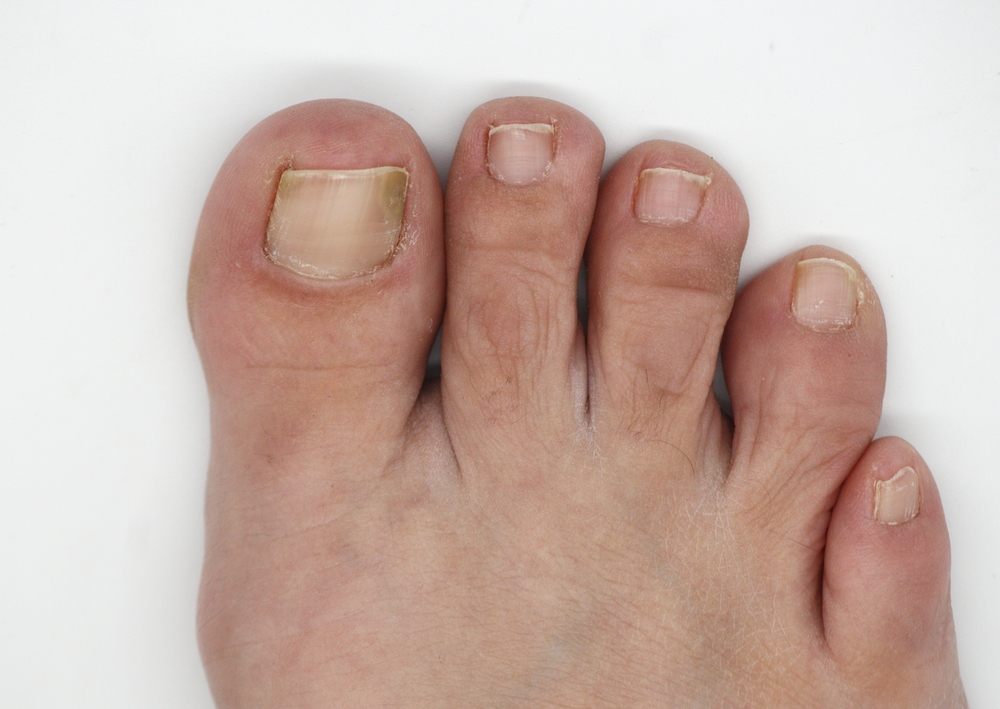What Are the Most Common Causes of Fungal Toenail Infections?
Published April 25, 2022.

A fungal toenail infection may just be a cosmetic problem, an ugly discoloration of the toenail that is easily treated with an antifungal cream. However, it can also signify underlying metabolic or immune system disorders, such as diabetes or psoriasis.
Toenail fungus is also known as onychomycosis, and it can make the nails thicker and brittle—you may even detect an unpleasant odor from the infected toenails.
Different Types of Fungal Toenail Infections
Fungi thrive in dark, warm, and moist places and are extremely contagious and easy to pick up when exposed. An example is walking barefoot in public areas such as shower rooms, swimming pools, and the gym.
Fungal toenail infections are usually one of four kinds:
1. Distal or Lateral Subungual Onychomycosis
These are the most common form of fungal toenail infection, accounting for approximately 85% of cases and caused by the dermatophyte Trichophyton rubrum. These fungi feed on the keratin of the nails.
Visually, it usually starts with a dot of yellow color on the nail bed that gradually spreads from the edges to the center—often, it spreads beyond the nail bed. With time, the whole nail can crumble and split (1).
2. White Superficial Onychomycosis (WSO)
This is caused by Trichophyton mentagrophytes and is characterized by affecting the outer layer of the nail plate. However, the nail doesn't come out but can be covered with a white, chalky powder (2).
3. Proximal Subungual Onychomycosis
This is the least common form of fungal toenail infection and is rare in healthy people. It is mostly seen in people with compromised immune systems, such as HIV patients. The point of fungal entry is the proximal nail fold region (3).
4. Candidal Onychomycosis
This is a yeast infection affecting the nail and is more common in fingernails than toenails. It is responsible for 5-10% of fungal nail infections (4).
What Causes Fungal Toenail Infections?
The most common cause of toenail fungus are:
Dermatophytes
These are keratinophilic fungi, which means that they feast on keratin, the protein that forms the cells of your nails. Around 85-90% of all cases of toenail fungus are caused by these dermatophytes, which are:
- Trichophyton mentagrophytes
- Trichophyton violaceum
- Trichophyton rubrum
The latter is the most common cause of nail fungus (5).
Non-dermatophytes
Non-dermatophytes are molds and yeasts that cause secondary fungal infections of your nails because they penetrate the surface through gaps and cuts that are already present or via a nail that is injured. It usually discolors the nail and thickens the nail plate (6).
Who Is Most at Risk of Developing Fungal Toenail Infections?
People who are at higher risk of getting toenail fungus are:
- Athletes Being physically more active results in heavier sweating. Additionally, athletes tend to wear tight-fitting shoes and socks that can make their feet warm and moist, a perfect environment for the fungus to thrive. Athlete’s foot is a fungal infection affecting the skin near their toes that can spread to toenails if not treated.
- Diabetics Toenail infection is twice as common in diabetics than in non-diabetic people. Poor circulation, nerve damage due to high blood sugar, and delayed wound healing make diabetics more prone to this fungal infection.
- People with hyperhidrosis Fungi need a warm and moist environment to thrive. People with hyperhidrosis sweat profusely, making it conducive for the fungi to grow.
- The elderly Older individuals are more prone to toenail infection as their nails dry out with age, leading to cracks within the nail.
- People with nail injuries This gives the fungi an opening to infect.
- People with peripheral vascular disease (PVD) The body needs oxygenated blood to work properly. In PAD, the blood flow is hampered, thus reducing your body's ability to function properly, making it a perfect host for fungus.
- Those with weakened immune systems The good bacteria that protect your body from these fungi are highly compromised, which can be exacerbated by the overuse of antibiotics. Good bacteria help prevent fungal invasion.
- Psoriasis Psoriasis causes progressive damage to the nail, giving the nail fungus an open field to work on.
Can You Treat Fungal Toenail Infection?
Yes, you can treat fungal toenail infection. There are many effective treatments for toenail fungus.
Natural remedies for toenail fungus include Epsom salt, tea tree oil, and iodine. Other than that, keep your feet dry and let them breathe. In case these treatments don't work, get yourself checked by a dermatologist or a podiatrist to receive an antifungal medication.
In general, fungi live on sugar. Therefore, if you reduce your sugar and carb intake, your risk of the toenail fungus returning will be minimal.







